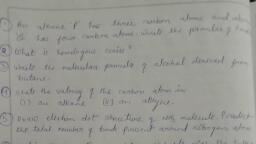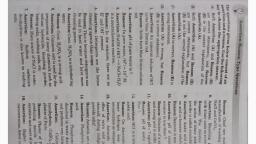Question 1 :
On sending an ultrasonic wave form a ship towards the bottom of a sea, the time interval between sending the wave and receiving it back is found to be 1.5 s. If the velocity of wave in sea water is 1400 $ms^{-1}$ find the depth of the sea.
Question 2 :
Write the equation of motion at a point 2 cm from its midpoint
Question 3 :
When a compression pulse is sent towards bottom of sea from a stationary ship it is observed that its echo is heard after $2\ s.$ If bulk modulus of elasticity of water is $2\times 10^{9}\ N/m^2 $, mean temperature of water is $4$ and mean density of water is $1000\ kg/m^3,$ then depth of sea will be :<br/>
Question 4 :
A tuning fork A when sounded with a tuning fork B of frequency $558 Hz$ produces $4$ beats per second.When A is loaded with a little wax and sounded with B, beats stop. Then , the frequency of A is
Question 5 :
Two sound sources $S_1$ and $S_2$ of frequencies 324 Hz and 320 Hz are placed at certain separation. An observer is moving away from $S_1$ towards $S_2$ on line joining them. If he hears no beats then speed of observer is $(v=344 m/sec):$
Question 6 :
When a sound wave enters the ear, it sets the eardrum into oscillation, which  in turn causes oscillation of 3 tiny bones in the middle ear called ossicles. This oscillation is finally transmitted to the fluid filled in inner portion of the ear termed as inner ear, the motion of the fluid disturbs hair calls within the inner ear which transmit nerve impulses to the brain with information that a sound is present. The three bones present in the middle ear are named as hammer, anvil and stirrup. Out of these the stirrup is the smallest one and this only connects the middle  ear to inner ear as shown in the figure below. The area of stirrup and its extent of connection with the inner ear limits the sensitivity of the human ear. Consider a person's eat whose moving part of the eardrum has an area of about 43 mm$^{2}$ and the area of stirrup is about 3.2 mm$^{2}$. The mass of ossicles is negligible. As a result, force  exerted by sound wave in air on eardrum and ossicles is same as the force exerted by ossicles on the inner ear. Consider a sound wave having maximum pressure fluctuation of $3\times10^{-2}$ Pa from its normal equilibrium pressure value which is wqual to $10^{5}$ Pa. Frequency of sound wave is 1200 Hz. <br/>Data: Velocity of sound wave in air is  332 m/s. Velocity of sound wave in fluid (present in inner ear) is 1500 m/s. Bulk modulus of air is $1.42\times10^{5}$ Pa. Bulk modulus of fluid is $2.18\times10^{9}$ Pa.<br/><br/><br/>Find the pressure amplitude of given sound wave in the fluid of inner ear. 
Question 7 :
Assertion: Sound shadows are generally not so well defined as those of light.
Reason: The wavelength of sound waves are very large in comparison to that of light waves.
Question 8 :
A ship sends a longitudinal wave towards the bottom of the sea. The wave returns from the bottom of the sea after $2.0\space s$. The bulk modulus of the sea water is $2.2\times10^9\space Nm^{-2}$ and the density of water is $1.1\space g\space cm^{-3}$. The depth of the sea is about
Question 9 :
A sound of intensity $I$ is greater by $3.0103\ dB$ from another sound of intensity $10\ nW\ c{ m }^{ -2 }$ . The absolute value of intensity of sound level $I$ in ${ Wm }^{ -2 }$ is :<br/>
Question 10 :
If eight persons are to address a meeting, then the number of ways in which a specified speaker is to speak before another specified speaker is?
Question 11 :
Assertion: A thin metal rod is just held between two rigid supports without producing any strain on it. The temperature of the rod subsequently increases by a few degrees. As a result the velocity of the transverse waves along the rod increases. The velocity of the longitudinal waves also increases.
Reason: The velocity of the transverse waves depends upon the tension whereas the velocity of the longitudinal waves depends upon Young's modulus and density of the material.
Question 12 :
A motor cycle starts from rest and accelerates along a straight path at $2 m/s^2$. At the starting point of the motor cycle there is a stationary electric siren. How far has the motor cycle gone when the driver hears the frequency of the siren at $94\%$ of its value when the motor cycle was at rest?(Speed of sound $=330 ms^{-1}$)
Question 13 :
Length of a string of density $\rho$ and Young's modulus $Y$ under tension is increased by $1/n$ times of its original length. Find the new value of speed of the wave.
Question 14 :
If the volume elasticity (i.e. bulk modulus) of fresh water and the sea water are assumed to be the same. It is necessary that for the velocity of the sound to be the same ,
Question 15 :
A progressive sound wave of frequency $500$ Hz is traveling through air with a speed of $350$ m/s. A compression maximum appears at a place at a given instant. The minimum time interval after which the rarefaction maximum occurs at the same point is?
Question 16 :
A rod of length one meter is rigidly clamped at its midpoint. Longitudinal stationary waves are set up in such a manner that there are two nodes on either side from its midpoint. The amplitude of anti-node is 2 micrometer. What is the frequency of the rod if Young's modulus of the rod is $2\times 10^{11}N/m^{2}$ and the density of rod is $8000 kg/m^{3}$?
Question 17 :
The frequency of a fork is $200$ Hz. The distance through which sound travels by the time the fork make $16$ vibrations is(velocity of sound in air is $340$ m/s).
Question 18 :
A ship sends a longitudinal wave towards the bottom of the sea. The wave returns from the bottom of the sea after $2.0\space s$. The bulk modulus of the sea water is $2.2\times10^9\space Nm^{-2}$ and the density of water is $1.1\space g\space cm^{-3}$. The depth of the sea is about
Question 19 :
A glass tube of length 1.0 m is completely filled with water. A vibrating tuning fork of frequency 500 Hz is kept over the mouth of the tube and the water is drained out slowly at the bottom of the tube. If velocity of sound in air is 330 m/sec then total number of resonance that occure will be :
Question 20 :
A man standing $25$ m away from a wall produces a sound and receives the reflected sound. Calculate the time in seconds after which he receives the reflected sound if the speed of sound in air is $350$ $ms^{-1}$.
Question 21 :
An electrically maintained tuning fork vibrates with constant frequency and constant amplitude. If the temperature of the surrounding air increases but pressure remains constant, the sound produced will have .........
Question 22 :
A pendulum has a frequency of 5 vibrations per second. An observer starts the pendulum and fire a gun simultaneously. He hears echo from the cliff after 8 vibrations of the pendulum. If the velocity of sound in air is 340  $ms^{-1}$, find the distance between the cliff and the observer :<br/>
Question 23 :
Two men stand a certain distance apart beside a long metal fence on a still day. One man places his ear against the fence while the other gives the fence a sharp knock with a hammer. Two sounds separated by a time interval of $0.5$ second, are heard by the first man. If the velocity of sound in air is $330\space ms^{-1}$ and in the metal $5280\space ms^{-1}$, how far apart are the men?
Question 24 :
The frequency of a man's voice is 300 Hz and its wavelength is 1 meter. If the wavelength of a child's voice is 1.5 m, then the frequency of the child's voice is :<br>
Question 25 :
Assertion: When we start filling an empty bucket with water, the pitch of sound produced goes on decreasing.
Reason: The frequency of man voice is usually higher than that of woman.
Question 26 :
A man standing in front of a mountain at a certain distance beats a drum at regular intervals. The drumming rate is gradually increased and he finds that the echo is not heard distinctly when the rate becomes $40$ per minute. He then moves nearer to the mountain by $90$ m and finds the echo is again not heard when the drumming rate becomes $60$ per minute. <br/>(a) The distance between the mountain and the initial position of the man and (b) The velocity of sound are:<br/>
Question 27 :
Sound of frequency 1000 Hz from a stationary source is reflected from an object approaching the source at 30 m/s, back to a stationary observer located at the source. The speed of sound in air is 330 m/s. The frequency of the sound heard by the observer is<br><br>
Question 28 :
When a sound wave of frequency 300 Hz passes through a medium, the maximum displacement of the particle of the medium is 0.1 cm. The maximum velocity of the particle will be:
































